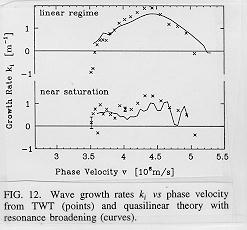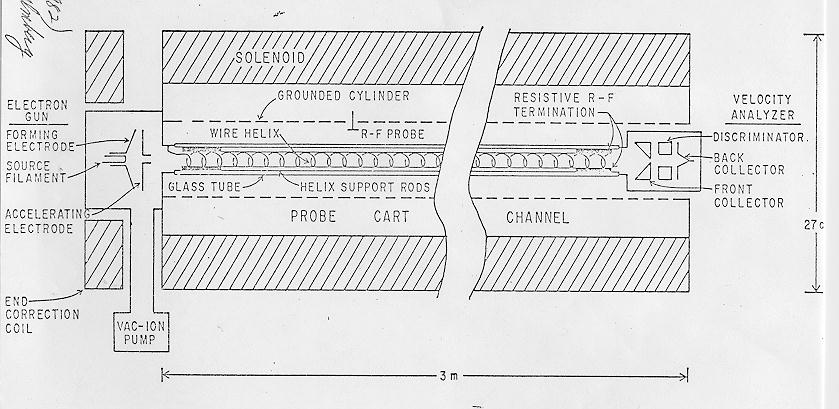

At saturation, significant mode-coupling results in wave correlations smaller than 0.5 with their launch values. Experimentally, each wave is separated into two components, one proportional to the launch amplitude and the other due to mode-coupling. The mode-coupling component growth rate is about three times larger than the ensemble-averaged wave growth rate, which is in agreement with a four-wave coupling model. Strongest coupling is observed between waves whose wavelengths match within about a turbulent trapping length.
Despite this mode coupling, the average wave growth rates are still close to those predicted by quasi-linear theory, even in the regime of saturation (Fig.12). In the linear regime, the measured ensemble-averaged wave growth rates and beam velocity diffusion rates agree reasonably with quasi-linear and resonance-broadening theory; in the nonlinear regime up to saturation, the discrepancies are larger, but not consistent with a general growth rate enhancement.

The NSF grant also provided 2 years of graduate student support for a separate theory group interested in the quasi-linear theory as it applies to our TWT experiment. Analytic calculations using the theory of two-point correlations suggest that in the weak turbulence regime, the nonlinear enhancement of mode growth is smaller than predicted. This theory work is thus consistent with the observations on the TWT.
In related experiments on TWT, we have investigated the phase relationship between three
waves: a wave of large amplitude that trapped an electron beam and an upper and a lower sideband
of small amplitude. This phase relationship is conveniently given by a time-independent quantity,
called the "modulational phase,"  , that is the sum of the two sideband phases in the frame
of the trapping wave. Physically
, that is the sum of the two sideband phases in the frame
of the trapping wave. Physically  describes the modulation in time of the superposition
of the three waves. Under some circumstances, mode-coupling results in phase-locking between
the sidebands, and
describes the modulation in time of the superposition
of the three waves. Under some circumstances, mode-coupling results in phase-locking between
the sidebands, and  becomes constant, independent of its initial value.
becomes constant, independent of its initial value.
The two growing sidebands can be interpreted as a single normal mode of the Kruer, Dawson, Sudan macro-particle model. The measured sideband growth rates, wavenumber shifts, modulational phase and amplitude ratio qualitatively agree with the model. However, the simple model has limited quantitative utility, and quantitative agreement is found only with computer simulations that follow the full phase-space distribution of the particles.
The two sets of TWT experiments formed the basis for the Ph.D. thesis of Dr. Dirk Hartmann in 1994.
Experiments on TWT will continue to focus on the saturation process of the weak warm beam instability. The goal is to understand whether coherent beam-phase-space structures develop which change the growth rates of the waves. To this end, we are investigating mode-coupling and are measuring wave growth rates and beam diffusion rates. The conceptual simplicity of this instability still spurs theoretical and computational predictions that need to be tested experimentally. Our measurements are the most complete and accurate available, and we plan to improve them further by eliminating two problems.
A new externally-clocked oscilloscope with a bandwidth of 100 MHz will be used to digitize the received waves, eliminating the need for our present homodyning circuit. It will then be possible to measure all nonlinearly generated modes, even those outside the launched spectrum, and to fully describe the wave coherence using bi-and tri-spectral analysis.
A redesigned cathode will eliminate the abrupt upper edge in our otherwise smooth "warm" electron beam. We will oscillate the beam energy at RF frequency, using phase-mixing in a drift region to remove the oscillations before the slow wave structure. With the smoother distribution, non-local effects become negligible, simplifying the theoretical description. Comparisons with theory are thus not only simplified, but the growth rate error bars (which require spatial averaging) are also reduced.
Recent theoretical analysis suggests that certain phase relationships between waves in the launched specrum may be maintained well into the nonlinear regime. We intend to investigate this effect by tailoring our launched spectrum. Preliminary experiments indicate that phase-coherence among some waves reduces the energy transfer from the beam to the waves: presumably, some phase relationships increase the transfer.